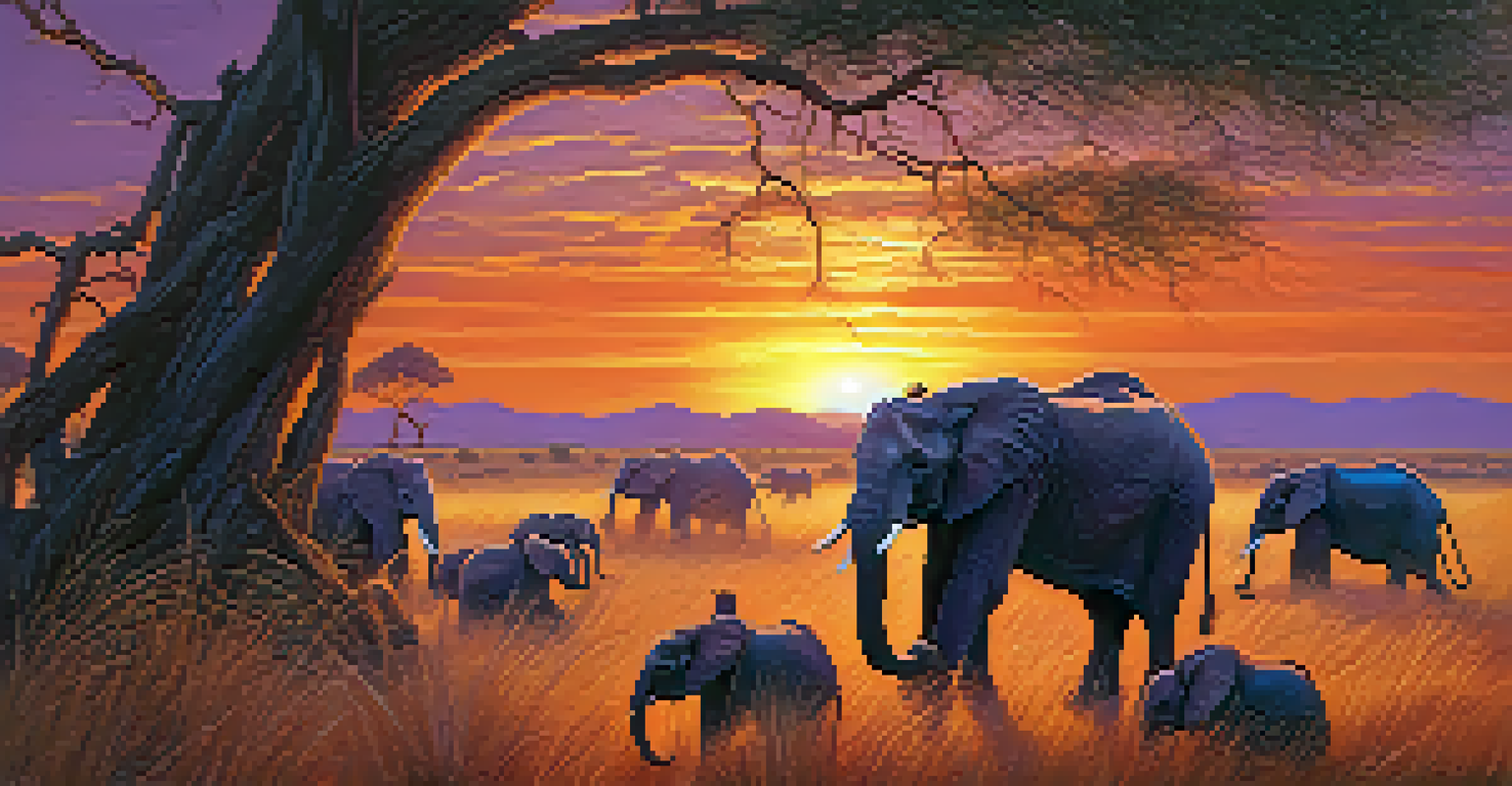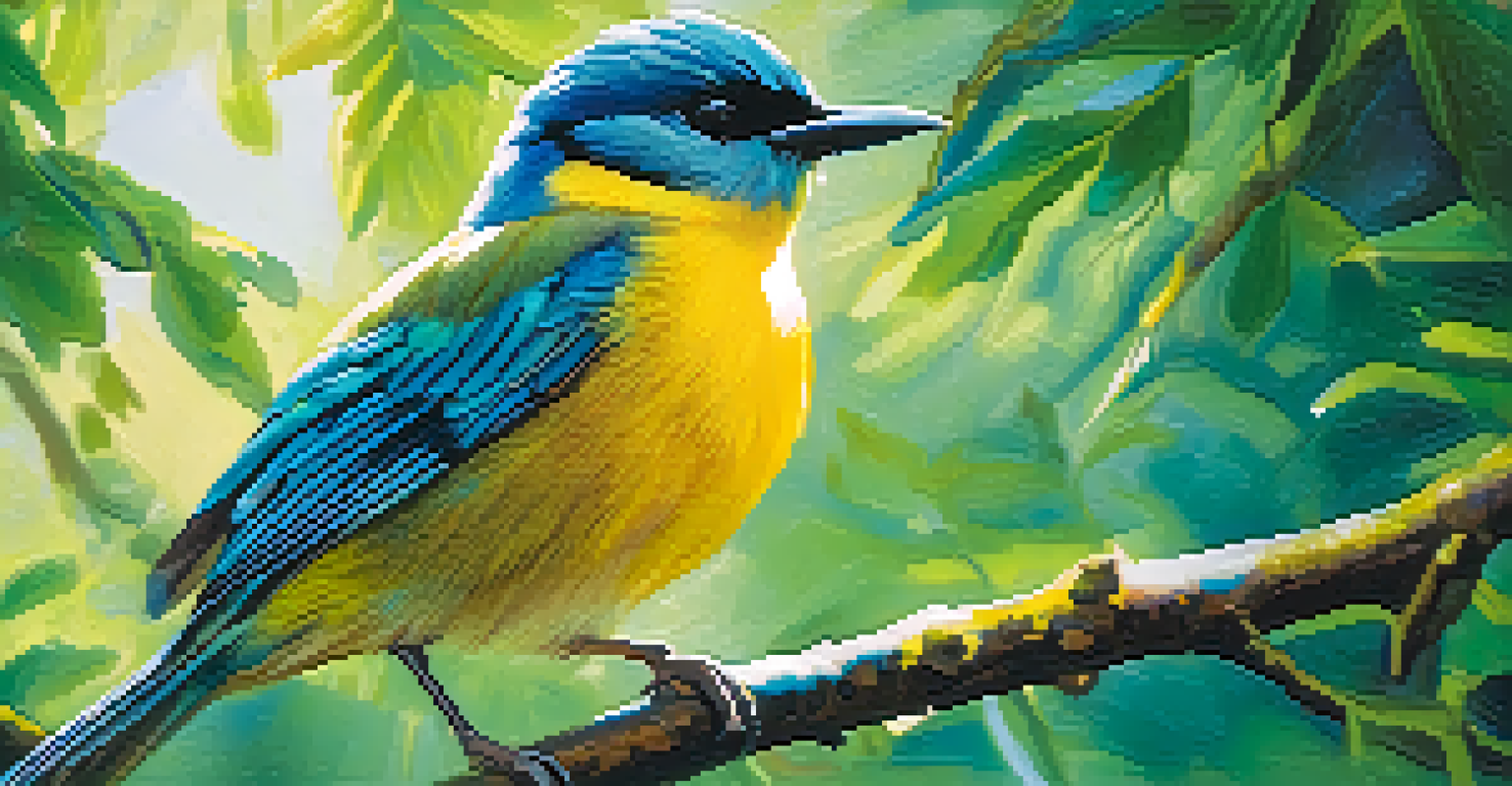Wildlife Watching in National Parks: What to Expect

Understanding the Best Times for Wildlife Viewing
Wildlife is often most active during certain times of the day, like dawn and dusk. Early mornings can be magical, as many animals are just waking up and starting their day. Similarly, evenings offer a chance to see creatures preparing for nightfall. Knowing when to go can significantly enhance your chances of spotting wildlife.
In every walk with nature one receives far more than he seeks.
Seasons also play a big role in wildlife visibility. For instance, during spring, many animals are nurturing their young, making them more visible. Conversely, in winter, some species might hibernate or migrate, limiting your viewing options. It's important to research the best seasons for specific parks to tailor your experience.
Lastly, weather can influence wildlife behavior. Milder temperatures often lead to more active animals, whereas extreme conditions might keep them hidden. Planning your visit around the weather forecast can help maximize your wildlife watching opportunities.
Essential Gear for Wildlife Watching Adventures
Having the right gear can make all the difference in your wildlife watching experience. Binoculars are a must for spotting animals from a distance, allowing you to observe their behavior without disturbing them. A good pair can bring distant creatures into clear view, enhancing your overall experience.

Comfortable clothing and sturdy footwear are also crucial. National parks often require some hiking to reach prime viewing spots, so wear layers to adapt to changing weather. It's wise to bring a backpack with essentials like water, snacks, and a first-aid kit to ensure a comfortable outing.
Best Times for Wildlife Viewing
Wildlife is most active during dawn and dusk, and seasonal changes significantly affect visibility.
Don’t forget to pack a camera! Capturing moments with wildlife can be incredibly rewarding, but remember to respect their space. Use a zoom lens to get those close-up shots without intruding on their habitat, allowing you to document your adventure while keeping the animals safe.
Respecting Wildlife and Their Habitats
When wildlife watching, it’s crucial to maintain a respectful distance from animals. Approaching too closely can stress them and disrupt their natural behavior. Most parks have guidelines on how far to stay from different species, so familiarizing yourself with these rules is essential for both your safety and the animals'.
The earth has music for those who listen.
Another key aspect is to leave no trace. This means cleaning up after yourself and ensuring that you don’t disturb the environment. Littering can harm habitats and the animals that live there, so packing out what you pack in is a simple way to contribute positively.
Lastly, be mindful of the sounds you make. Loud noises can scare wildlife away, preventing you from seeing them and affecting their natural behaviors. Being quiet and patient can reward you with unforgettable encounters, making your experience more enriching.
Viewing Strategies for Different Types of Wildlife
Different animals require different strategies for effective viewing. For example, if you're aiming to see birds, early morning is usually the best time, as many species are singing and active then. Bring a field guide to help identify birds by their calls and markings, enhancing your enjoyment of the experience.
For larger mammals like bears or deer, patience is key. These animals often roam within specific territories, so researching their habits can help you predict where to find them. Setting up near a water source, where they often come to drink, might increase your chances of a sighting.
Essential Gear for Your Adventure
Packing the right gear, such as binoculars and comfortable clothing, enhances your wildlife watching experience.
If you’re interested in smaller creatures like reptiles or amphibians, look for them near water bodies or in warmer, sunny areas. These animals can be elusive, so being observant and still is crucial. Using a good pair of binoculars can also help spot them without having to get too close.
Understanding Park Regulations for Wildlife Observers
National parks have specific regulations in place to protect wildlife and ensure the safety of visitors. Familiarizing yourself with these rules before your visit can enhance your experience and help preserve the environment. Regulations may include designated viewing areas and restrictions on feeding wildlife.
Each park may have unique guidelines reflecting its specific ecosystem. For instance, some parks may prohibit certain activities during breeding seasons to protect vulnerable species. Respecting these regulations is crucial for the continuation of wildlife populations and their habitats.
Moreover, staying informed about any changes in park policies can help you plan your visit better. Many parks have visitor centers or websites where you can find the latest information, ensuring a responsible and enjoyable wildlife watching experience.
Photography Tips for Capturing Wildlife Moments
Wildlife photography can be incredibly rewarding, but it does come with its own set of challenges. The key is to be patient and wait for the right moment. Animals often don’t perform on cue, so having your camera ready and being prepared to wait can lead to stunning shots.
Using a zoom lens is highly recommended, especially when trying to capture animals from a distance. This allows for close-up shots without disturbing them, preserving their natural behavior. Additionally, consider using a tripod to stabilize your camera for clearer images, especially in low light.
Respect Wildlife and Regulations
Maintaining a respectful distance and following park regulations are crucial for the safety of both wildlife and visitors.
Lastly, pay attention to the lighting conditions. Early mornings and late afternoons, known as the golden hours, provide the best natural lighting for photography. Soft, diffused light can enhance the colors and textures in your images, making your wildlife photography even more captivating.
Planning Your Wildlife Watching Trip: Top Parks to Visit
When planning your wildlife watching adventure, consider visiting some of the top national parks known for their rich biodiversity. Yellowstone National Park, for instance, is famous for its bison and wolves, offering a chance to see these majestic animals in their natural habitat. Researching which parks are known for specific wildlife can help tailor your trip to your interests.
Another great destination is the Everglades National Park, where you can spot alligators, manatees, and a variety of bird species. This unique ecosystem provides a different experience compared to mountainous parks. Each park has its own charm and wildlife, so exploring a variety can enhance your understanding of different species and their habits.

Lastly, consider the accessibility of these parks. Some may have established viewing platforms or guided tours that can enhance your experience. Checking visitor reviews and park websites can provide insights into what to expect, making your planning process smoother and more enjoyable.